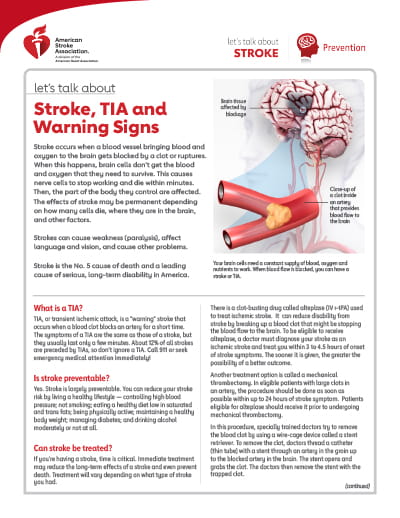Let’s Talk About Stroke, TIA and Warning Signs
 Stroke occurs when a blood vessel bringing blood and oxygen to the brain gets blocked by a clot or ruptures. When this happens, brain cells don’t get the blood and oxygen that they need to survive. This causes nerve cells to stop working and die within minutes. Then, the part of the body they control are affected. The effects of stroke may be permanent depending on how many cells die, where they are in the brain, and other factors.
Stroke occurs when a blood vessel bringing blood and oxygen to the brain gets blocked by a clot or ruptures. When this happens, brain cells don’t get the blood and oxygen that they need to survive. This causes nerve cells to stop working and die within minutes. Then, the part of the body they control are affected. The effects of stroke may be permanent depending on how many cells die, where they are in the brain, and other factors.
Strokes can cause weakness (paralysis), affect language and vision, and cause other problems.
Stroke is the No. 5 cause of death and a leading cause of serious, long-term disability in America.
What is a TIA?
TIA, or transient ischemic attack, is a “warning” stroke that occurs when a blood clot blocks an artery for a short time. The symptoms of a TIA are the same as those of a stroke, but they usually last only a few minutes. About 12% of all strokes are preceded by TIAs, so don’t ignore a TIA. Call 911 or seek emergency medical attention immediately!
Is stroke preventable?
Yes. Stroke is largely preventable. You can reduce your stroke risk by living a healthy lifestyle — controlling high blood pressure; not smoking; eating a healthy diet low in saturated and trans fats; being physically active; maintaining a healthy body weight; managing diabetes; and drinking alcohol moderately or not at all.
Can stroke be treated?
If you’re having a stroke, time is critical. Immediate treatment may reduce the long-term effects of a stroke and even prevent death. Treatment will vary depending on what type of stroke you had.
There is a clot-busting drug called alteplase (IV r-tPA) used to treat ischemic stroke. It can reduce disability from stroke by breaking up a blood clot that might be stopping the blood flow to the brain. To be eligible to receive alteplase, a doctor must diagnose your stroke as an ischemic stroke and treat you within 3 to 4.5 hours of onset of stroke symptoms. The sooner it is given, the greater the possibility of a better outcome.
Another treatment option is called a mechanical thrombectomy. In eligible patients with large clots in an artery, the procedure should be done as soon as possible within up to 24 hours of stroke symptom. Patients eligible for alteplase should receive it prior to undergoing mechanical thrombectomy.
In this procedure, specially trained doctors try to remove the blood clot by using a wire-cage device called a stent retriever. To remove the clot, doctors thread a catheter (thin tube) with a stent through an artery in the groin up to the blocked artery in the brain. The stent opens and grabs the clot. The doctors then remove the stent with the trapped clot.
What are the warning signs of stroke?
You and your family should recognize the warning signs of stroke. You may have some or all of these signs. Note the time when symptoms start and call 911 or the emergency response number in your area immediately. Stroke is a medical emergency!
Don’t ignore these warning signs, even if they go away.
Stroke Warning Signs:
- Sudden numbness or weakness of the face, arm or leg, especially on one side of the body
- Sudden confusion, trouble speaking or understanding
- Sudden trouble seeing in one or both eyes
- Sudden trouble walking, dizziness, loss of balance or coordination
- Sudden severe headache with no known cause
F.A.S.T. is an easy way to remember how to recognize a stroke and what to do. Spot a stroke fast.
Face drooping
Arm weakness
Speech difficulty
Time to call 911
How can I learn more?
- Call 1-888-4-stroke (1-888-478-7653) or visit stroke.org to learn more about stroke or find local support groups.
- Sign up for our monthly Stroke Connection e-news for stroke survivors and caregivers at StrokeConnection.org.
- Connect with others who have also had an experience with stroke by joining our Support Network at stroke.org/SupportNetwork.
Do you have questions for your doctor or nurse?
Take a few minutes to write down your questions for the next time you see your health care provider. For example:
Which facility close to me is best equipped to treat me if I am having stroke symptoms?
How can I reduce my risk for stroke?
We have many other fact sheets to help you make healthier choices to manage your condition or care for a loved one. Visit stroke.org/LetsTalkAboutStroke to learn more
© Copyright 2020 American Heart Association, Inc., a 501(c)(3) not-for-profit. All rights reserved. American Stroke Association is a registered trademark of the AHA. Unauthorized use prohibited.